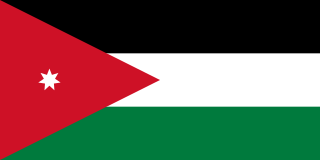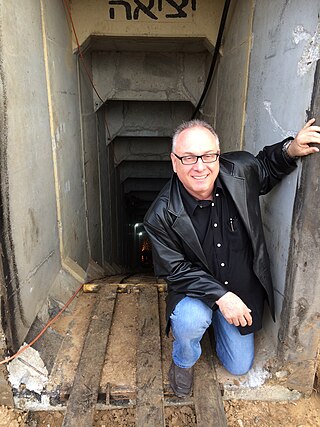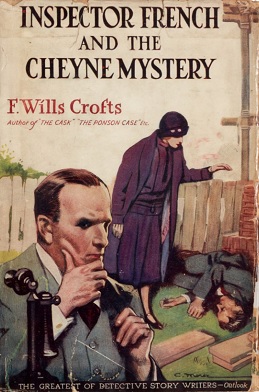
The Ark of the Covenant, also known as the Ark of the Testimony or the Ark of God, is believed to have been the most sacred religious relic of the Israelites. It is described as a wooden chest coated in pure gold and topped off by an elaborate golden lid known as the mercy seat. According to the Book of Exodus and First Book of Kings in the Hebrew Bible and the Old Testament, the Ark contained the Tablets of the Law, by which God delivered the Ten Commandments to Moses at Mount Sinai. According to the Book of Exodus, the Book of Numbers, and the Epistle to the Hebrews in the New Testament, it also contained Aaron's rod and a pot of manna.

The menorah is a seven-branched candelabrum that is described in the Hebrew Bible and in later ancient sources as having been used in the Tabernacle and in the Temple in Jerusalem.

The Dead Sea Scrolls, also called the Qumran Caves Scrolls, are a set of ancient Jewish manuscripts from the Second Temple period. They were discovered over a period of 10 years, between 1946 and 1956, at the Qumran Caves near Ein Feshkha in the West Bank, on the northern shore of the Dead Sea. Dating from the 3rd century BCE to the 1st century CE, the Dead Sea Scrolls include the oldest surviving manuscripts of entire books later included in the biblical canons, along with extra-biblical and deuterocanonical manuscripts from late Second Temple Judaism. At the same time, they cast new light on the emergence of Christianity and of Rabbinic Judaism. Almost all of the 15,000 scrolls and scroll fragments are held in the Shrine of the Book at the Israel Museum, located in the city of Jerusalem. The Israeli government's custody of the Dead Sea Scrolls is disputed by Jordan and the Palestinian Authority on territorial, legal, and humanitarian grounds—they were mostly discovered following the Jordanian annexation of the West Bank and were acquired by Israel after Jordan lost the 1967 Arab–Israeli War—whilst Israel's claims are primarily based on historical and religious grounds, given their significance in Jewish history and in the heritage of Judaism.

According to the Hebrew Bible, the tabernacle, also known as the Tent of the Congregation, was the portable earthly dwelling used by the Israelites from the Exodus until the conquest of Canaan. Moses was instructed at Mount Sinai to construct and transport the tabernacle with the Israelites on their journey through the wilderness and their subsequent conquest of the Promised Land. After 440 years, Solomon's Temple in Jerusalem superseded it as the dwelling-place of God.

The British administrative headquarters for Mandatory Palestine, housed in the southern wing of the King David Hotel in Jerusalem, were bombed in a terrorist attack on July 22, 1946, by the militant right-wing Zionist underground organization Irgun during the Jewish insurgency. 91 people of various nationalities were killed, including Arabs, Britons and Jews, and 46 were injured.

East Jerusalem is the sector of Jerusalem that was held by Jordan after the 1948 Arab–Israeli War, as opposed to the western sector of the city, West Jerusalem, which was held by Israel. Under international law, East Jerusalem is considered a part of the West Bank and, therefore, of the Palestinian territories. A number of states recognize East Jerusalem as the capital of the State of Palestine, whereas other states assert that East Jerusalem "will be the capital of Palestine", while referring to it as "an occupied territory".
Meir Har-Zion was an Israeli military commando.

The Jordanian administration of the West Bank officially began on April 24, 1950, and ended with the decision to sever ties on July 31, 1988. The period started during the 1948 Arab-Israeli War, when Jordan occupied and subsequently annexed the portion of Mandatory Palestine that became known as the West Bank, including East Jerusalem. The territory remained under Jordanian control until it was occupied by Israel during the 1967 Six Day War and eventually Jordan renounced its claim to the territory in 1988.

Lionel Davidson FRSL was an English novelist who wrote spy thrillers. He received Authors' Club Best First Novel Award once and the Gold Dagger Award three times.

The Night of Wenceslas is the debut novel of British thriller and crime writer Lionel Davidson. This Bildungsroman describes the reluctant adventures of Nicolas Whistler, a dissolute young man of mixed English and Czech parentage who finds himself caught up against his will in Cold War espionage. The novel won the Crime Writers' Association's Gold Dagger Award in 1960, and the Author's Club First Novel Award. It was filmed in 1964 under the title Hot Enough for June.

Nahman Avigad, born in Zawalow, Galicia, was an Israeli archaeologist.

Eric H. Cline is an American author, historian, archaeologist, and professor of ancient history and archaeology at The George Washington University (GWU) in Washington, D.C., where he is Professor of Classics and Anthropology and the former Chair of the Department of Classical and Near Eastern Languages and Civilizations, as well as Director of the GWU Capitol Archaeological Institute. He is also the advisor for the undergraduate archaeology majors, for which he was awarded the GWU Award for "Excellence in Undergraduate Departmental Advising" (2006). Cline served as co-editor of the Bulletin of the American Schools of Oriental Research along with Christopher Rollston from 2014–2020.

The Knesset Menorah is a bronze menorah that is 4.30 meters high and 3.5 meters wide and weighs 4 tons. It is located at the edge of Wohl Rose Park opposite the Knesset in Jerusalem. It was designed by Benno Elkan (1877–1960), a Jewish sculptor who escaped from his native Germany to the United Kingdom. It was presented to the Knesset as a gift from the British Parliament on April 15, 1956, in honour of the eighth anniversary of Israeli independence.
Matthew Beynon Rees is a Welsh novelist and journalist. He is the author of The Palestine Quartet, a series of crime novels about Omar Yussef, a Palestinian sleuth, and of historical novels and thrillers. He is the winner of a Crime Writers Association Dagger for his crime fiction in the UK and a finalist for the National Jewish Book Award for fiction in the US. His latest novel is the international thriller China Strike, the second in a series about an agent with US Immigration and Customs Enforcement.

The Jerusalem Waqf and Al-Aqsa Mosque Affairs Department, also known as the Jerusalem Waqf, the Jordanian Waqf or simply the Waqf, is the Jordanian-appointed organization responsible for controlling and managing the current Islamic edifices on the Al-Aqsa mosque compound in the Old City of Jerusalem, known to Jews as the Temple Mount, which includes the Dome of the Rock. The Jerusalem Waqf is guided by a council composed of 18 members and headed by a director, all appointed by Jordan. The current director of the Waqf, since 2005, is Sheikh Azzam al-Khatib.
Henry Soskin, better known as Henry Lincoln, was a British author, television presenter, scriptwriter, and actor. He co-wrote three Doctor Who multi-part serials in the 1960s, and — starting in the 1970s — inspired three Chronicle BBC Two documentaries on the alleged mysteries surrounding the French village of Rennes-le-Château — and, from the 1980s, co-authored and authored a series of books of which The Holy Blood and the Holy Grail was the most popular, becoming the inspiration for Dan Brown's 2003 best-selling novel, The Da Vinci Code. He was the last living person to have written for Doctor Who in the 1960s.

Jewish paper cutting is a traditional form of Jewish folk art made by cutting figures and sentences in paper or parchment. It is connected with various customs and ceremonies, and associated with holidays and family life. Paper cuts often decorated ketubbot, Mizrahs, and ornaments for festive occasions. Paper cutting was practiced by Jewish communities in both Eastern Europe and North Africa and the Middle East for centuries and has seen a revival in modern times in Israel and elsewhere.

Sam Philipe is an Israeli sculptor. He is known for his sculptures of biblical and New Testament figures.

Hashemite custodianship refers to the Jordanian royal family's role in tending Muslim and Christian holy sites in the city of Jerusalem. The legacy traces back to 1924 when the Supreme Muslim Council, the highest Muslim body in charge of Muslim community affairs in Mandatory Palestine, chose Hussein bin Ali as custodian of Al-Aqsa. The custodianship became a Hashemite legacy administered by consecutive Jordanian kings.

The Cheyne Mystery is a 1926 mystery thriller novel by Freeman Wills Crofts. It is the second in his series of novels featuring Inspector French, a prominent figure of the Golden Age of Detective Fiction. It followed on from his debut in Inspector French's Greatest Case, in which Crofts introduced a character who was more methodical and less flamboyant than many of the other great detectives who followed in the wake of Sherlock Holmes.

















